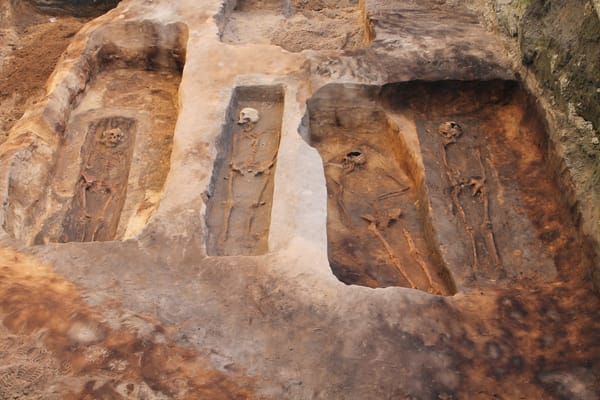Decoding the Evolution of the Plague (Yersinia pestis)




The story of Yersinia pestis, the bacterium responsible for the infamous plague, weaves through our history like a phantom, affecting empires, cultures, and the very fabric of society. Recent research has dived deep into the archaeological and archival remnants of this pathogen, unraveling the mysterious process of its attenuation, or reduction in virulence, across three significant plague pandemics. This remarkable tale of microbial evolution spans centuries and continents, leaving an indelible mark on human civilization while simultaneously adapting to survive in an ever-changing world.
Imagine the bustling marketplaces and serene towns of Medieval Denmark, now silent fields of bones and whispers as archaeologists unearth secrets of pandemics past. Among the samples collected and studied, three stood out: A146x3001, G371, and A1155x1155. These ancient remains revealed unique "gap bridging" sequences - a hallmark of the ancient strains that had diversified over centuries. Each of these samples acts as a silent testimonial to plagues that ravaged Europe, reflecting a bacterium evolving under pressure from human hosts and societal changes.
The archaeological findings surrounding plague pandemics provide a fascinating glimpse into the ancient world, revealing tales of tragedy, survival, and societal transformation. Various dig sites across Europe have unearthed the skeletal remains of plague victims, with these human remains often bearing the hallmarks of Yersinia pestis. In Scandinavian excavations, spanning several centuries, notable graves have been rediscovered in Denmark and Norway, where medieval burial grounds sometimes confused with battlegrounds are suddenly revealed through the lens of modern archaeological science to be final resting places of plague victims.
As archaeologists sift through the soil, they don't just find skeletons but a plethora of grave goods reflecting the lives of plague victims. While these trinkets tell tales of their own, they also escort skeletons to laboratories where geneticists search for clues. Sequencing ancient DNA from Danish samples like G25Bx98 and G861x1035 has illuminated a fascinating reality: while their genetic signatures resemble those of the plague that haunted the Middle Ages, there are subtle shifts indicating a gentle weakening in the plague's deadly efficacy.
One cannot help but be struck by the stories that each individual artifact and skeleton tells. Among the grave goods, researchers find everyday items hurriedly buried with their owners. Coins, jewellery, and household wares found alongside skeletal remains suggest the speed and chaos of plague events, indicating that victims were sometimes interred with the things they valued most, perhaps in haste or fear. The sample named G861x1035, from medieval Denmark, exhibited modifications in its genome that have helped decode how ancient strains spread across Europe, and how some managed to persist while others faded into oblivion.
It is like walking through a hallway lined with portraits of this bacterium's victims, each face a genome etched in time. The study reveals that historical pandemics, while devastating, may have acted as evolutionary pressures shaping the bacterium. There's an intriguing hint in ancient strains from Denmark and their perplexing relationship with today's less virulent strains. Specific changes in regions called 'pla', which contribute to the bacterium's virulence, are recorded, narrating a saga of powers waning across generations.
Imagine diving into the past, where scholars meticulously extract DNA from centuries-old remains. The study examined samples from diverse plague pandemics, revealing extraordinary metamorphoses in the plague bacterium over time. Ancient samples from Denmark provided a treasure trove of data, allowing researchers to map genetic changes with precision. To the untrained eye, bones are mere remnants, but to the astute geneticist, each bone conveys a narrative of the bacterium's history.
Delving into the DNA sequences, researchers identified "gap bridging reads," links in a genetic chain that have evaded earlier studies. These genetic footprints correspond to specific deletions and insertions that hint at Y. pestis adapting to changing environments and hosts, showing how the bacterium can evolve to survive through time. The genome of Yersinia pestis, recovered from ancient DNA in teeth and bones, reveals a pathogen that has persisted through time, adapting and evolving with remarkable shifts in virulence and distribution throughout different pandemics.
The team distinguished between strains: the wildtype plague that ravaged populations and the less virulent strains, which subtly persisted. These findings illustrate a nuanced interaction between pathogen and host throughout history. Scientists have uncovered strains of Y. pestis with reduced virulence, notably those that don't kill their hosts as quickly or as efficiently as their virulent wild counterparts, raising compelling questions about the benefits to the bacterium when its virulence is toned down.
The tale of the plague is a dramatic one, stretching across centuries and continents, leaving a mark as indelible as any in history. Consider the ancient records, fraught with accounts of towns and cities brought to their knees by the relentless march of the Great Pestilence. The Second Pandemic, including the notorious Black Death, incised deep cuts into the history of European nations, with archaeological remnants continuing to provide specters of its past wrath and resilience in the face of adversity.
From Copenhagen to Vietnam, the archaeological and molecular evidence tells a thrilling story of survival and adaptation. Take the case of flea transmission - typically, Y. pestis must jump from a dying rat to a flea just before the rat succumbs. However, with reduced virulence strains, the extended life of rat hosts diminishes transmission opportunities. Yet, paradoxically, these strains seem to thrive longer in the manner of the persistent plague outbreaks that plagued Medieval Europe and beyond.
The research on these genomes visualizes a subtle tug-of-war between humans and the pathogen. While humans developed resistance through social changes and potential genetic evolution, the bacterium undertook a journey of its own, weaving mutations into survival strategies. The coloration of historical maps changes too, with evidence of resistance as some populations possessed genetic markers that might have helped them endure, weaving the narrative of a dynamic dance between a microbe and its mammalian hosts over millennia.
Archaeology extends beyond skeletal remains - it is about constructing the social and environmental infrastructures these pandemics left in their wake. The remnants of once-busy marketplaces suddenly abandoned, towns reckless in their expanse, farms left to become overgrown serve as silent witnesses to cycles where life re-conquers land after societal collapse. Modern insights complement these findings, where contemporary Y. pestis strains echo their medieval ancestors, offering a tableau of genetic adaptations captured through cutting-edge genomic sequencing.
Beyond the genetic code, this exploration creates a vivid picture of historical pandemics and their legacy. It's not just about sequences on a screen; it's about connecting dots that map the journey of one of humankind's most infamous foes. As ancient epidemics waxed and waned, they left behind a genetic footprint as complex and storied as the history books that document them. Here, archaeological biology and living history collide, offering more than just a historical panorama - it's a syllabus on survival and adaptation, teaching us the nuanced lessons of evolution etched in the plague's battlescape.
In the end, it is a profound testament to evolution and resilience, seen both in societies that reconstructed themselves and in humanity's persistent survival against the odds. The interplay of scientific rigor and historical inquiry delivers an exquisite understanding of how such a small bacterium could stipple its narrative across the vast expanse of human history. This exploration, through the lens of DNA, shows us how science can illuminate not only how past pandemics shaped human history but also how they continue to inform modern understanding of pathogenic evolution, revealing the fascinating trade-offs between infection times and transmission rates that echo the fundamental theories of pathogen evolution.
Comments